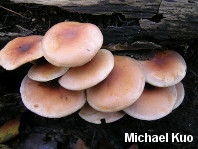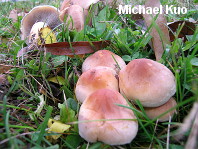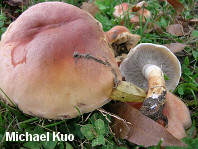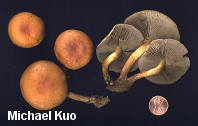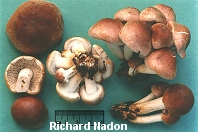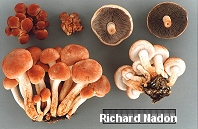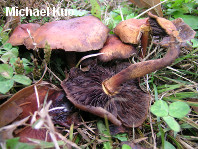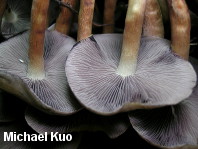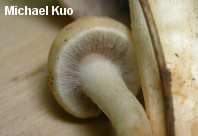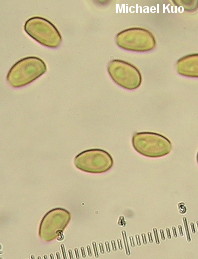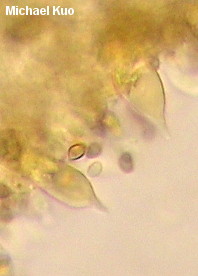| Major Groups > Gilled Mushrooms > Dark-Spored > Hypholoma > Hypholoma sublateritium |

|
Hypholoma sublateritium [ Basidiomycota > Agaricales > Strophariaceae > Hypholoma . . . ] by Michael Kuo This widely distributed fall mushroom, sometimes called the "brick cap," can be found growing in tight clusters on hardwood stumps and logs. It is fairly easily recognized by its habitat, its brick-red cap with a paler cap margin, its purple-gray gills, and the way the stem often bruises and stains yellow. If you can catch Hypholoma sublateritium when it's still very young, you can see its partial veil, which mycologists call "submembranous," looking like a cross between a cortina and a more substantial veil. Naematoloma sublateritium is a synonym. Description: Ecology: Saprobic; growing in clusters on decaying hardwood logs and stumps; fall; widely distributed in North America but more common east of the Rocky Mountains. The illustrated and described collections are from Michigan, Illinois, and Québec. Cap: 3-10 cm; convex, becoming broadly convex, nearly flat, or irregular in age; with an incurved margin when young; bald; dry or moist; brick red overall, but paler (pinkish to buff) on the margin, especially when young; the margin sometimes hung with wispy veil fragments. Gills: Attached to the stem; close or crowded; when young covered by a whitish, cortina-like veil; whitish when very young, but soon pale gray to gray, becoming purple-gray to dark purple brown with maturity; short-gills frequent. Stem: 4-12 cm long; 1-2 cm thick; more or less equal, or twisted and tapering to base due to the clustered growth pattern; bald, or finely hairy near the apex; often featuring an ephemeral or persistent ring zone near the top; yellowish to whitish above, brown to reddish below; sometimes bruising and staining yellow. Flesh: Firm; whitish to yellowish. Odor and Taste: Odor not distinctive; taste mild or slightly bitter. Chemical Reactions: KOH brownish on cap surface. Spore Print: Purple brown. Microscopic Features: Spores 6-7 x 3-4 µ; ellipsoid; smooth; thin-walled; with an obscure pore; yellowish in KOH. Pleuro-chrysocystidia abundant; fusoid-ventricose to mucronate; up to 40 x 10 µ. Cheilocystidia fusoid-ventricose, cylindric, or irregular, with subcapitate apices; hyaline; thin-walled; to 35 x 8 µ. Pileipellis a cutis; elements golden in KOH. REFERENCES: (Schaeffer, 1774) Kummer, 1871. (Saccardo, 1887; Smith, 1949; Smith, 1951; Stamets, 1978; Smith, Smith & Weber, 1979; Phillips, 1991/2005; Lincoff, 1992; Barron, 1999; Roody, 2003; McNeil, 2006; Miller & Miller, 2006.) Herb. Kuo 09059508, 11060402, 11290901. This website contains no information about the edibility or toxicity of mushrooms. |
© MushroomExpert.Com |
|
Cite this page as: Kuo, M. (2014, February). Hypholoma sublateritium. Retrieved from the MushroomExpert.Com Web site: http://www.mushroomexpert.com/hypholoma_sublateritium.html |
